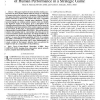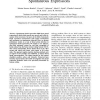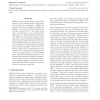52 search results - page 7 / 11 » View-Invariant Representation and Learning of Human Action |
AIIA
2005
Springer
14 years 2 months ago
2005
Springer
Abstract. In order to have a robotic system able to effectively learn by imitation, and not merely reproduce the movements of a human teacher, the system should have the capabiliti...
TSMC
2008
13 years 7 months ago
2008
This paper explores the issues faced in creating a sys-4 tem that can learn tactical human behavior merely by observing5 a human perform the behavior in a simulation. More specific...
JMM2
2006
13 years 8 months ago
2006
Spontaneous facial expressions differ from posed expressions in both which muscles are moved, and in the dynamics of the movement. Advances in the field of automatic facial express...
ICRA
2010
IEEE
13 years 7 months ago
2010
IEEE
— Allowing robots to communicate naturally with humans is a major goal for social robotics. Most approaches have focused on building high-level probabilistic cognitive models. Ho...
ICML
2004
IEEE
14 years 9 months ago
2004
IEEE
Reinforcement learning deals with learning optimal or near optimal policies while interacting with the environment. Application domains with many continuous variables are difficul...



